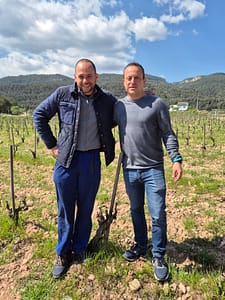Located just outside Montblanc in the heart of Conca de Barberà, Mas Foraster, also called Josep Foraster, is a family-run estate that has become one of the leading names in the revival of trepat – the region’s native red grape. Founded in 1998, the winery is now run by Ricard Sebastià Foraster, who not only oversees the estate but also serves as president of the Consejo Regulador of the DO Conca de Barberà. “Josep was both my grandfather and my uncle,” says Ricard.

The estate currently covers 34 hectares – 27 owned and the rest leased – and only estate-grown grapes are used. All vineyards are farmed organically, and biodynamic compost is applied. Elevations range from 280 to 550 metres around Montblanc, and up to 650 meters around Sarral and on the other side of the mountains. These high altitudes, along with calcareous and clay-rich soils, contribute to the wines’ freshness and clarity. According to Ricard, while clay brings more yield, calcareous soils provide greater concentration – but above all, it’s the cool climate that trepat needs.

Trepat, traditionally used in rosado and cava, is now taking centre stage. Mas Foraster has been a key player in this transformation, releasing their first red trepat in 2009 – the second on the market after Carles Andreu. Their red trepats are fermented spontaneously, with a 40-day maceration that continues even after fermentation ends. Sulphite levels are kept low, always under 40 mg/l, and ageing takes place exclusively in used barrels, foudres or concrete eggs.
The current range of trepat-based wines is wide and expressive:
Les Gallinetes 2024 (55% trepat, 45% garnatxa) is a light, juicy red with aroma of red berries, with fine tannins and a smooth, easy-drinking style.
Trepat 2023, made from seven old vineyards (60–96 years), grown in calcareous soils, undergoes long maceration in foudre and barrique. Ruby in colour, it shows red forest fruits and white pepper, with freshness, finesse and length.

Julieta 2023, named after Ricard’s mother and his daughter, from a single north-facing vineyard planted in 1940 at 450 metres, is aged seven months in concrete eggs. With aromas of raspberry and flowers, it has more structure and weight, firm tannins and a long, lingering finish.
Pep 2022, from 86-year-old vines at 580 metres, is made with whole clusters, foot-trodden in alabaster tanks. Light cherry red, the wine shows red fruits and herbs, with firm yet juicy structure and real depth.

In addition to red wines, Mas Foraster also makes noteworthy whites and skin-contact styles:
Blanc Selecció 2023 is a blend of macabeu, chardonnay and garnatxa gris. The wine is fermented in concrete eggs and sees some skin contact in foudre. Pale yellow with green hints, it shows citrus, yellow apple, good volume and bright acidity.
Brisat del Coster 2023, an orange wine made from macabeu (some of which also goes into the Blanc Selecció), undergoes 25 days of skin contact in steel and concrete, with no added sulphites. Golden in hue, it offers notes of citrus peel, flowers, herbs and apricot, with light tannins and a textured, fresh palate. Ricard notes that macabeu, with its lower oxidative character than garnatxa gris, results in a lighter colour.

The cellar is overseen by Kepa Martínez, whose mother is from the Basque Country, hence the name Kepa. Fermentations are spontaneous and temperature-controlled by natural means – “fermentation starts when the temperature rises,” says Ricard.
With a clear focus on trepat and a deep commitment to sustainable farming and precision winemaking, Mas Foraster stands as one of the most respected producers in the Conca de Barberà today – a house where tradition, innovation and identity converge.
Leave a Comment





































